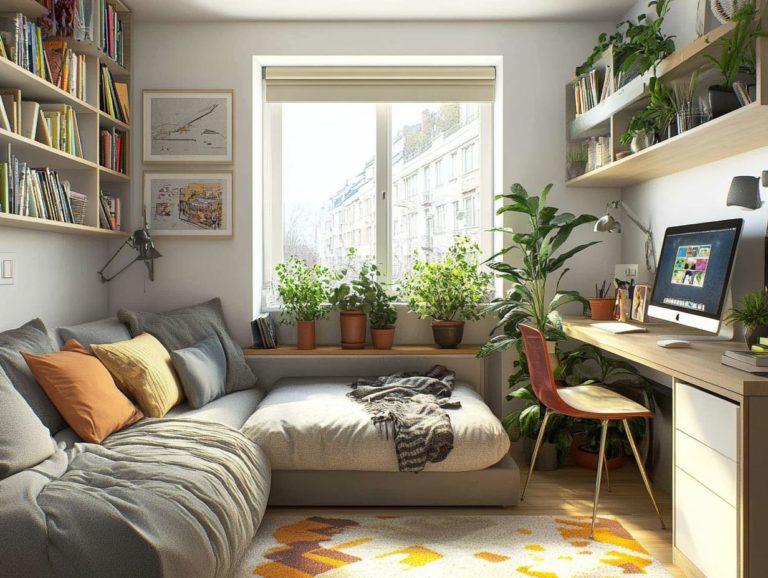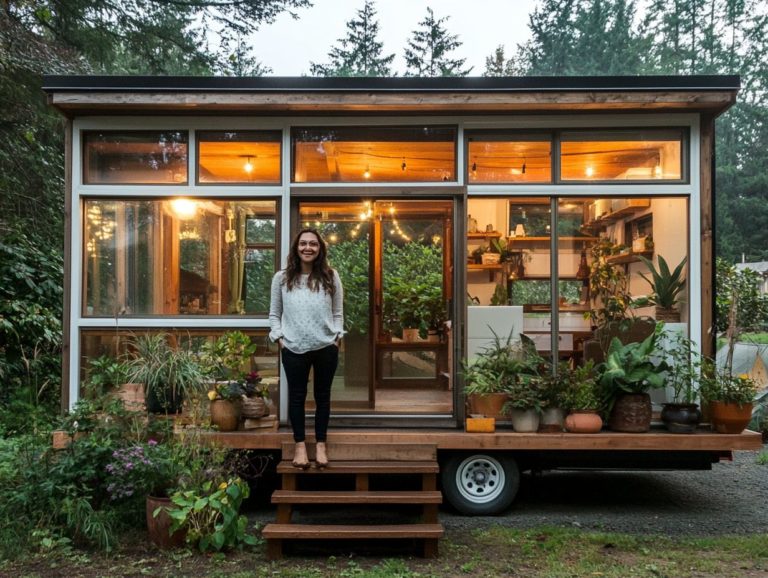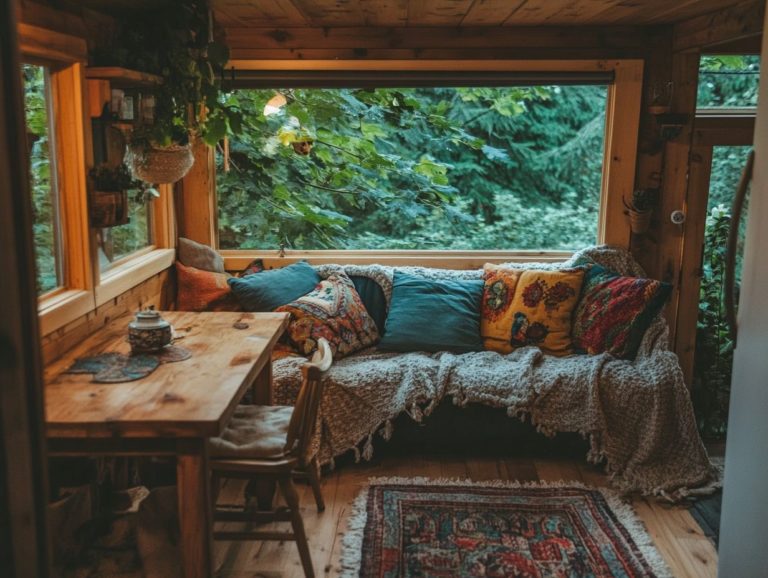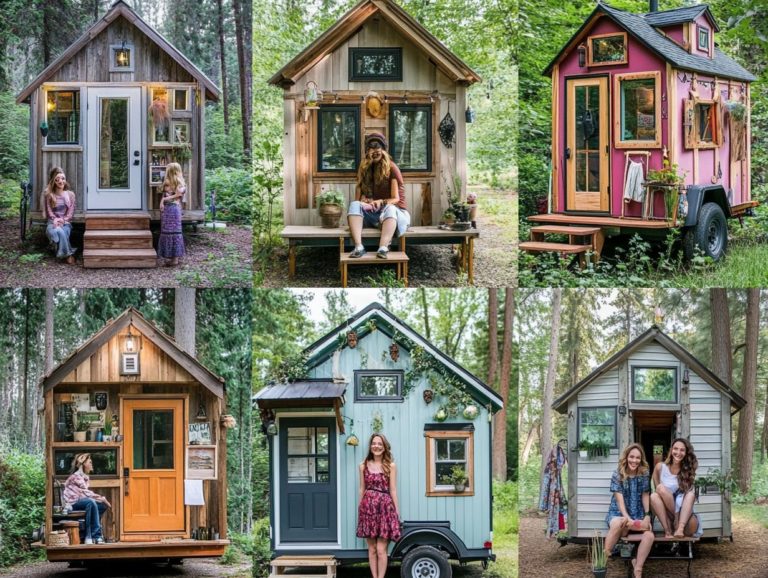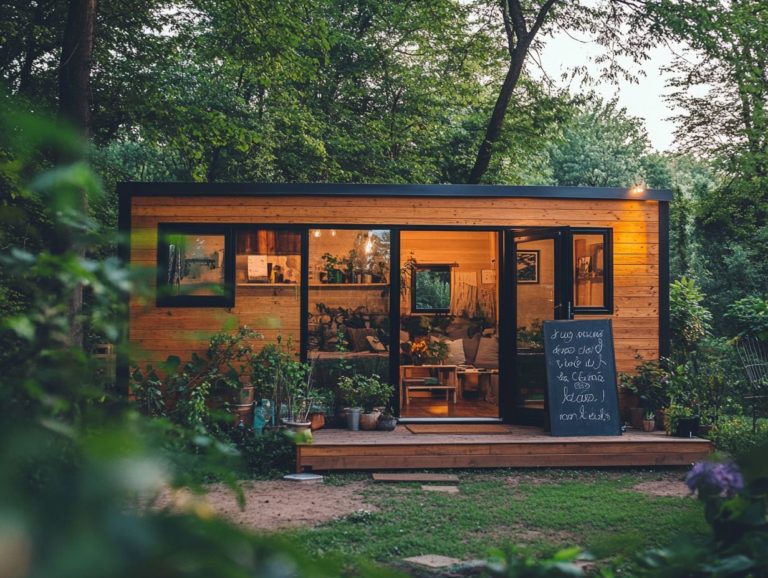Exploring the Tiny House Lifestyle Benefits
The tiny house lifestyle has captivated countless individuals, presenting a refreshing alternative to conventional living. As you seek sustainable and cost-effective ways to live, tiny homes emerge as a fascinating solution.
This article delves into the defining characteristics of a tiny house, highlighting its myriad benefits from significant financial savings to a reduced environmental footprint. It also addresses the challenges that accompany the downsizing journey.
You will be guided through the essential steps to transition into this minimalist lifestyle, ensuring you are prepared for the journey ahead.
Contents [hide]
- Key Takeaways:
- Understanding the Tiny House Lifestyle
- Benefits of Living in a Tiny House
- Challenges of Living in a Tiny House
- How to Transition to a Tiny House Lifestyle
- Frequently Asked Questions
- What is the tiny house lifestyle and what are its benefits?
- How can exploring the tiny house lifestyle benefit my finances?
- What are the environmental benefits of living in a tiny house?
- Will living in a tiny house require me to give up certain amenities?
- Is the tiny house lifestyle suitable for families?
- Can I build my own tiny house to explore the lifestyle benefits?
Key Takeaways:
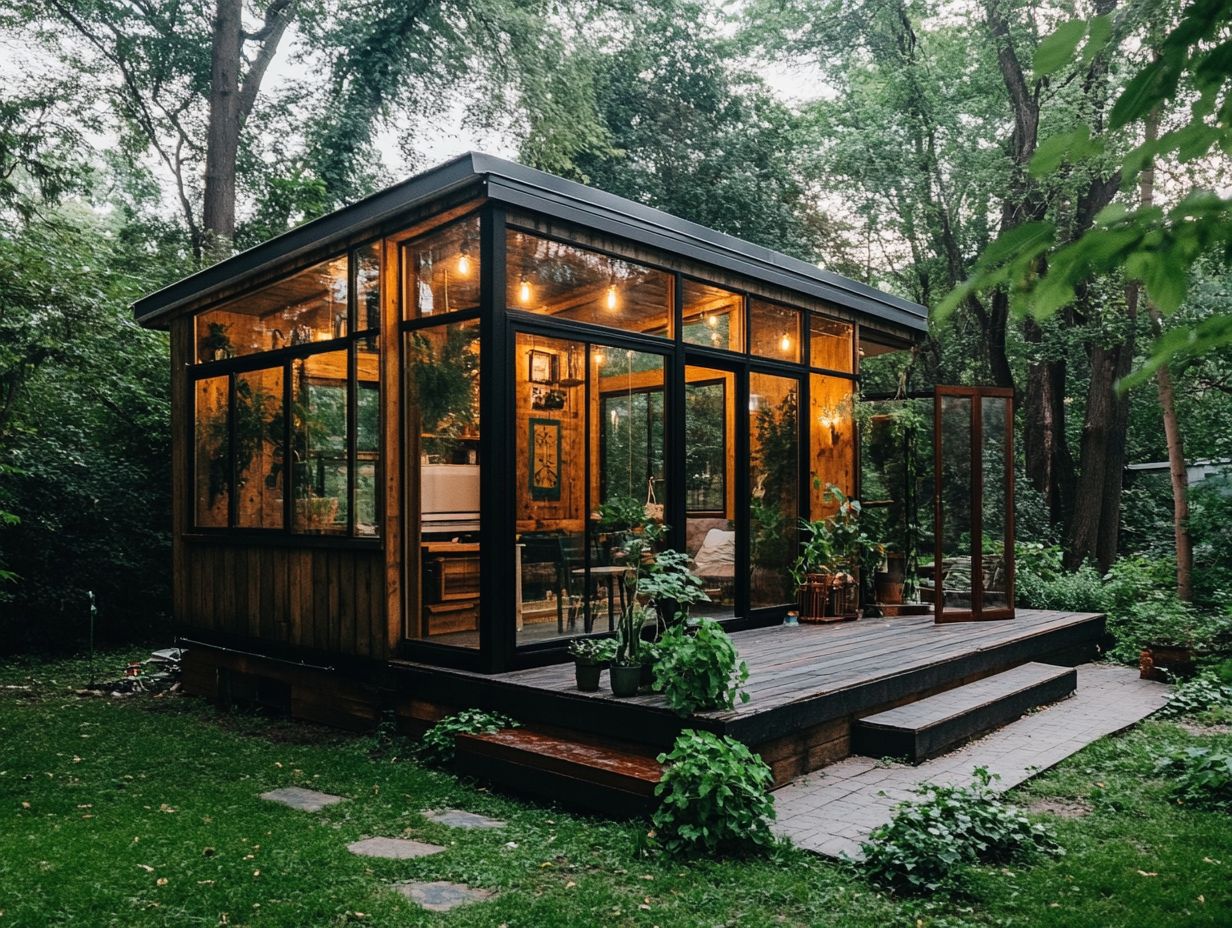
- Enjoy financial benefits, such as lower living expenses and increased financial freedom.
- Have a positive environmental impact by promoting sustainable and eco-friendly living.
- Embrace simplicity and minimalism, leading to a more intentional and fulfilling lifestyle.
Understanding the Tiny House Lifestyle
Understanding the tiny house lifestyle requires embracing its core principles, which advocate for financial freedom, sustainable living, and a minimalist approach. This way of life fosters a deeper connection to nature and enhances your overall quality of life.
The increasing popularity of tiny homes marks a shift toward affordable housing solutions that emphasize thoughtful buying and eco-friendly practices. This appeals to a growing movement dedicated to reducing environmental impact.
By adopting this lifestyle, you can cultivate intentional living habits. It leads to a simplified existence where materialism gives way to meaningful experiences, flexibility, and stronger community connections.
What is a Tiny House?
A tiny house is your ticket to a dwelling that s beautifully compact, typically measuring between 100 and 400 square feet. Designed to maximize space and functionality, these homes represent the essence of cost-effective living.
In a tiny house, efficient layouts and furniture that serves more than one purpose come together to create a cozy environment that promotes intentional living. Unlike conventional homes, which can stretch into thousands of square feet, the allure of a tiny house lies in its simplicity and minimalism.
Mobile homes and tiny house trailers bring their own advantages, particularly the joy of portability. This means you can experience various locations while still enjoying the comforts of a stable home base. Such flexibility encourages an adventurous lifestyle and can lead to significant reductions in living expenses, making the benefits of custom tiny house designs an enticing alternative to the financial strains often associated with larger, traditional properties.
Benefits of Living in a Tiny House
Embracing life in a tiny house presents numerous advantages. You ll enjoy financial benefits like reduced expenses, rental property opportunities, and the potential for mortgage-free living.
You ll also have a positive impact on the environment, thanks to lower utility bills, solar panels, and a significantly reduced carbon footprint. This lifestyle choice boosts your financial health and opens doors to exciting opportunities for everyone.
Financial Advantages
The financial benefits of living in a tiny house are compelling. You can enjoy significant savings through reduced utility bills, lower maintenance costs, and even the possibility of living mortgage-free. This creates the opportunity to cut down on debt and achieve greater financial freedom.
These advantages cultivate a lifestyle marked by simplicity and independence. By embracing the tiny home movement and implementing smart design solutions for tiny house living, you can free yourself from hefty mortgage payments and unpredictable housing expenses.
Living in a smaller space reduces energy consumption and encourages you to adopt a minimalist lifestyle. This liberates you from excess belongings and the costs tied to them. Ultimately, those who choose this path often find their savings growing, allowing them to invest in travel, build a nest egg, or create an emergency fund.
This shift enhances your overall financial stability and peace of mind.
Ready to explore the tiny house lifestyle? Consider making this exciting transition and discover the benefits of open floor plans in tiny houses to enjoy a simpler, more sustainable life!
Environmental Impact
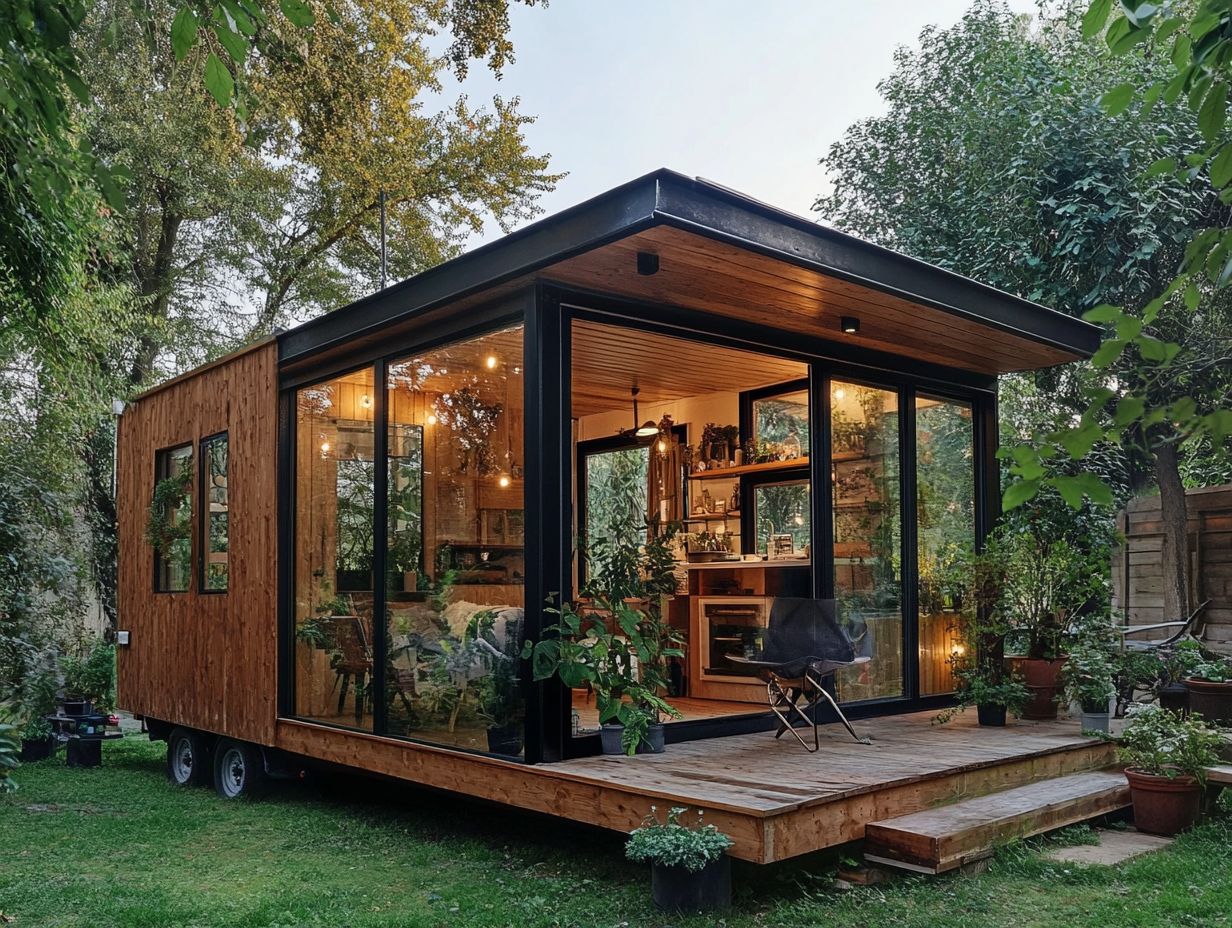
The environmental impact of tiny homes is undeniably profound, as they embody the principles of sustainable living. By using eco-friendly materials, you can significantly reduce your carbon footprint, which means lowering the amount of harmful gases you produce.
Tiny homes often use renewable resources like reclaimed wood and recycled metals. These materials minimize waste and require fewer resources to produce. By choosing energy-efficient designs, you can lower your utility bills and diminish your reliance on nonrenewable energy sources.
Tiny homes promote a minimalist lifestyle, encouraging you to prioritize quality over quantity. This shift often leads to reduced consumption and less waste overall.
As more individuals adopt this intentional approach to living, you collectively contribute to a healthier planet. This demonstrates that smaller spaces can indeed lead to greater environmental benefits while promoting a sustainable building ethos.
Simplicity and Minimalism
Simplicity and minimalism lie at the heart of the tiny house lifestyle, inviting you to declutter and embrace an organized life. It prioritizes intentional living and the pursuit of experiences over material possessions.
By adopting these principles, you can create a sanctuary that values quality over quantity. This fosters deeper connections with loved ones and nature. Living in a tiny home encourages mindfulness, prompting you to evaluate what truly matters.
Design a space that reflects your core values. This thoughtful approach minimizes distractions and unlocks a profound sense of freedom. It allows you to travel lightly and concentrate on personal growth.
Ultimately, embracing simplicity within a compact living environment lays the groundwork for a more fulfilling and enriched life. It provides opportunities for self-discovery and personal growth.
Challenges of Living in a Tiny House
Living in a tiny house offers a wealth of benefits, but it also brings its own set of challenges. You ll need to navigate space limitations that demand meticulous planning and organization.
There are also legal considerations, such as building codes and zoning regulations that vary across the United States. Jump into this lifestyle ready for both the thrills and the challenges it brings!
Space Limitations
Space limitations in tiny homes call for a minimalist lifestyle. Careful organization is essential for maintaining an efficient and functional living environment that promotes flexibility and adaptability.
This shift toward living with less optimizes your space and cultivates a liberating sense of freedom from material excess. To truly maximize your limited square footage, consider incorporating multifunctional furniture think of a sofa that transforms into a bed or a dining table that expands when guests arrive.
Vertical storage solutions, like shelves and hooks, help you make the most of wall space while keeping your floors free of clutter. Embracing a seasonal wardrobe and opting for compact appliances will further enhance your organization.
Ultimately, these strategies create a harmonious atmosphere that blends comfort with practicality in the art of tiny living.
Legal Considerations
Legal considerations for tiny homes often depend on building codes and local rules about where you can put a tiny home. These regulations can greatly affect your ability to join the tiny house movement and live sustainably in a compact space, especially when it comes to customizations.
It s crucial to navigate these legal rules if you want to downsize and stay compliant. Many municipalities have specific requirements about size, height, and the materials used in construction, which can create challenges for tiny house enthusiasts.
By following these regulations, you not only ensure safety but also improve your chances of being accepted within communities. This acceptance can promote a greater embrace of the tiny house lifestyle.
Understanding these legal hurdles empowers you to find innovative solutions that respect local governance, such as rainwater harvesting and composting toilets, while aligning with the principles of minimalism and environmental responsibility.
How to Transition to a Tiny House Lifestyle
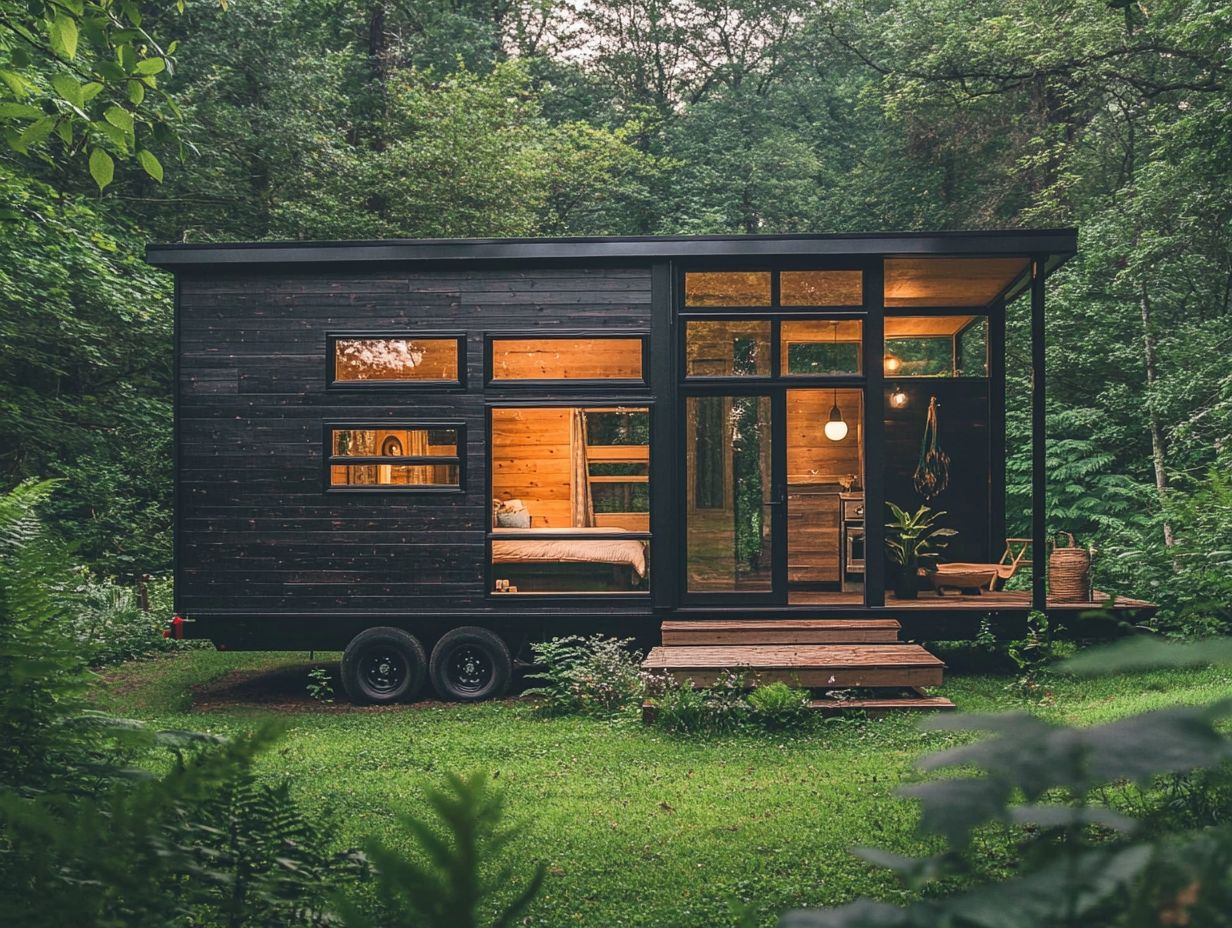
Transitioning to a tiny house lifestyle involves thoughtful steps. First, you ll need to downsize your belongings, simplify your living space, and decide whether to build or buy your tiny home.
Explore options like tiny house kits that can help you achieve financial freedom and a more intentional way of living.
Steps to Downsizing and Simplifying
Downsizing and simplifying can transform your life. This process involves a careful decluttering of your belongings and making intentional choices that embrace simplicity.
As you start this journey, it requires you to make deliberate decisions about what to keep and what to let go. Categorizing your items into essentials, sentimental keepsakes, and things to discard will help you see what truly adds value to your life.
Create a detailed plan to tackle specific areas like closets, storage spaces, and even digital files. Focus on joy and utility, recognizing that having fewer possessions can reduce stress and deepen your appreciation for what you have.
Every small step towards a clutter-free space enhances your organization and fosters a sense of peace and clarity in your everyday life.
Building or Buying a Tiny House
Choosing to build or buy your tiny house is a crucial step. Consider options like tiny house kits and eco-friendly building methods that can save you money.
This choice can change your life! When thinking about building a tiny home, the opportunity to customize every detail to reflect your personal style and values may resonate deeply.
If you decide to build, consider the time and effort involved in construction versus the convenience of purchasing a pre-made option. Budget constraints and ongoing maintenance will be important factors in your decision-making process.
Thinking about downsizing?
Living in a tiny house can transform your life. Adjusting to a smaller living space can be both challenging and rewarding.
This invites you to adopt simple living habits that enhance your quality of life.
This transition often makes you reevaluate your values.
Embracing minimalism means owning fewer things to create a more spacious living environment.
Letting go of excess belongings can be emotional but also opens doors for creativity and innovation.
Focusing on furniture that serves multiple purposes can make your tiny home a cozy and functional space.
Creating personalized corners, like a reading nook or a small garden, strengthens your connection to this new lifestyle.
Ultimately, it nurtures a profound sense of well-being and fulfillment.
Frequently Asked Questions
What is the tiny house lifestyle and what are its benefits?

The tiny house lifestyle involves living in a small, minimalist home that is typically less than 400 square feet.
The benefits include reduced living expenses, a lower environmental footprint, and a simpler, clutter-free lifestyle.
How can exploring the tiny house lifestyle benefit my finances?
By downsizing to a tiny house, you can significantly reduce your living expenses.
The cost of building and maintaining a small home is much lower than a traditional house. This can lead to financial freedom and the ability to save money for other things, such as travel or retirement.
What are the environmental benefits of living in a tiny house?
Tiny houses have a smaller carbon footprint due to their size and use of materials.
They also require less energy for heating and cooling, reducing your overall impact on the environment.
Many tiny homes use eco-friendly features, such as solar panels and composting toilets.
Will living in a tiny house require me to give up certain amenities?
While tiny houses may be smaller in size, they can still have many of the same amenities as traditional homes.
It all depends on your personal preferences and the design of your tiny house. Some tiny homes even have luxuries like full kitchens and bathrooms.
Is the tiny house lifestyle suitable for families?
While the tiny house movement may have originated with individuals or couples, it is becoming increasingly popular for families as well.
Many families are drawn to the close-knit living environment and the opportunity to spend more time together.
However, it’s important to carefully consider the space and functionality needed for your family before making the move.
Can I build my own tiny house to explore the lifestyle benefits?
Yes, you can! Building a tiny house can be a rewarding and cost-effective option.
However, it’s essential to research and plan carefully, as building codes and regulations for tiny homes vary by location.
You can also buy pre-fabricated tiny houses or hire a professional builder to construct your dream tiny home.

